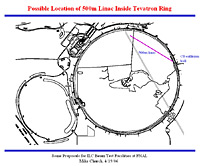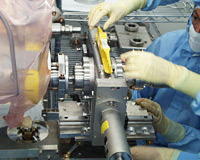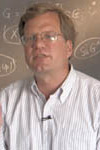 |
|
|
 |
Possible Proposal Presented for ILC Test Beam Facilities at Fermilab

One possible location for placing a linac inside the Tevatron ring as a test facility for the ILC. |
Before the International Linear Collider can be built, physicists and engineers must prove that the proposed baseline design will achieve the desired physics, requiring testing and R&D at laboratories and institutions around the world. As part of this process, Fermilab's Mike Church recently shared with attendees, at a weekly ILC R&D meeting, one possible proposal for ILC Test Beam Facilities that would utilize the lab's already existing infrastructure.
In an early stage of development and not yet endorsed by Fermilab management, the proposal will continue to be evaluated and reviewed not only by the lab but also by the Global Design Effort and the Department of Energy. "This is a work in progress," Church said. "We haven't thought too seriously about cost, location or a timeline yet. The tiered proposal allows you to make more rational decisions about what you're getting."
Put together by a team of scientists in March 2006, Church outlined a five-tiered plan in which each facility requires the previous one to be developed. With parts of the proposal already in action at Fermilab, the 5-tiered proposal is as follows:
| 1) |
e- source: Continue the ongoing R&D at the AZero photoinjector to study emittance preservation in a superconducting linac. |
| 2) |
e- source + 3 cryomodule superconducting linac: The basis for a system test of a single RF unit, consisting of a modulator, transformer, klystron, RF distribution, 3 cryomodules and feedback. As the current plan for the Fermilab ILC Test Area at the New Muon Lab (ILCTA – New Muon), this facility can be used to test cryomodules with full beam intensity up to approximately 750 MeV. |
| 3) |
e- source + 20 cryomodule superconducting linac: This 5 GeV linac, consisting of approximately 20 cryomodules and requiring about 220 metres in length, would be adequate to test emittance preservation techniques and alignment tolerances for the ILC – a primary beam physics concern for the machine. |
| 4) |
e- source + 20 cryomodule superconducting linac + 5 GeV e- damping ring in the Tevatron tunnel: After 2009, the majority of the Tevatron tunnel will be unused. The 5 GeV linac can be built inside the Tevatron ring, serving as an injector to a 5 GeV damping ring inside the 6 km Tevatron tunnel – something that will never have been done before with these specific conditions. |
| 5) |
e- source + 20 cryomodule superconducting linac + 5 GeV e- damping ring + positron source and associated beamlines: Using the positron source to produce the opposite of electrons, the linac can then accelerate them to 5 GeV. From there, the positrons can be injected into the e- damping ring to study electron cloud effects – a very uncertain issue. |
| |
|
| Read more... |
-- Elizabeth Clements
|
 |
|
|
 |
|
 |
 |
|
|
 |
String theory into practice

Cleanroom technicians ensure that every part is carefully aligned. |
Dust is never a welcome thing. But in DESY's cleanroom, where the cavities for the famous Module 6 are being assembled into a string this week, it is simply not tolerated: ten particles per cubic foot, that is all that is allowed. Any speck more would jeopardise the cavities' unique feature – their high gradient. So the seven DESY specialists working on the eight cavities are extremely careful, every touch is carefully engineered.
The string that is being assembled this week is for Module 6 – the last in the line for FLASH, the European XFEL's pilot facility and paid for by XFEL funds and the Europe-funded EUROFEL project. "This one is a multi-purpose module," explains Axel Matheisen, leader of the cavity preparation and assembly group. It doesn't only serve its main future purpose, accelerating electrons in FLASH, but many others at the same time: "We're testing the working procedure to assemble the module. The industry is looking over our shoulder to see how the process can be turned into mass production, and they check whether things can be changed and improved," says Matheisen. But that's not it yet: two scientists from Fermilab are also at DESY to learn the process first-hand and use it for the first American module, to be built by the end of this year. And of course it's important lessons to learn for the XFEL which will need 128 of these modules, containing 1000 cavities.
Read more...
-- Barbara Warmbein
|
 |
|
|
 |
ILC Communications Workshop -- Vancouver July, 2006

Jon Bagger, chair of the LCSGA Communication Committee |
The Linear Collider Steering Group Americas (LCSGA) Communications Committee is planning a half-day workshop for the afternoon of 18 July 2006 in conjunction with the Vancouver Linear Collider Workshop (VLWC).
The goal of this workshop is to train an "ILC communications squad" to give talks to scientific (both HEP and non-HEP) audiences. Interest in the ILC is growing quickly. Barry Barish cannot satisfy all the requests he gets for colloquia and seminars. We need to continue to build a concensus for the ILC both inside and outside the HEP community. The aim of this workshop is to provide participants with the tools they will need to put together a good ILC colloquium as well as to provide them with material, strategies and means to keep these up to date.
Read more...
LCSGA Communication Committee
Jonathan Bagger
Jim Brau
Neil Calder
Judy Jackson
Ritchie Patterson
William Trishuk |
 |
|
|
 |
From Interactions.org
9 May 2006
Particle Physics Panel Launches “Discovering the Quantum Universe” Report
Scientists of the High Energy Physics Advisory Panel, a group of distinguished physicists that provides advice to the Department of Energy’s Office of Science and to the National Science Foundation, today (May 9) announced the launch of a new publication that explains the excitement of 21st-century particle physics to audiences who are not science experts...
Read more...
From MSNBC
8 May 2006
Could cyclic universe explain mystery?
One of the biggest mysteries in cosmology could be explained by a controversial theory in which the universe explodes into existence not just once, but repeatedly in endless cycles of death and rebirth.
Read more... |
|
 |
 |
|
|
 |
Baseline Damping Rings

Dynamical aperture for one of the reference lattices |
One of the more difficult decisions we made last fall was which damping ring option to choose for our baseline. No recommendation came out of the Snowmass Workshop and our damping ring working group continued to study the question through much of the fall. They recommended a 6 km circular damping ring for electrons and two 6 km rings, one stacked above the other, for positrons.
The Damping Ring group has documented their work in an impressive 300 page document entitled, " Configuration Studies and Recommendations for the ILC Damping Rings" edited by A. Wolski (LBNL, Berkeley, CA), J. Gao (IHEP, Beijing, China, and S. Guiducci (LNF, Frascati, Italy) on behalf of the 47-member working group.
I commend this fine piece of work and recommend all those interested in the technical details of the ILC and the reasoning behind this particular design choice, to download and read this document. As a reminder, the job of the damping rings in the ILC is to sufficiently reduce the emittance of the beams by synchrotron radiation before the beams enter the main linac to be accelerated to 250 GeV. (see Director’s Corner, 23 November 2005) This is a challenging task because of such things as the long beam pulse, the large number of bunches, and the bandwidth of the injection / ejection kicker magnets.
Comparisons of damping rings options were performed in a "parametric study" by using a range of lattices that represented a variety of different configuration options. They studied beam dynamics, technical subsystems, costs, and operations issues for a number of configuration choices that included different circumferences, energies and lattice cell structures. They also considered different options for the various technical subsystems, such as the injection and ejection kicker magnets, and wigglers.
Based on their studies, the Damping Ring working group made a set of recommendations, highlighted by the following:
"The positron damping ring should consist of two (roughly circular) rings of approximately 6 km circumference in a single tunnel. Electron-cloud effects make a single ring of circumference 6 km or lower unattractive, unless significant progress can be made with mitigation techniques. Space-charge effects will be less problematic in a 6 km than in a 17 km ring, and achieving the required acceptance will be easier in a circular ring than in a dogbone ring."
Read more...
-- Barry Barish
Director's Corner Archive
|
 |
|
|
 |
Correction
Quite unexpectedly, NewsLine readers last week read about FLASH's
'unexpected' success of a 13.1 nm-wavelength (last week's issue) - an achievement that
the team has been working towards for weeks and thus came
everything but unexpectedly... What was unexpected though was that
the editors never noticed that 'unexpected' was supposed to be
'unprecedented' and quite simply got lost in translation from the
German. Our apologies!
Register for the Vancouver Linear Collider Workshop
On behalf of the ALCPG and GDE, the Local Organising Committee of the Vancouver Linear Collider Workshop, invites you to the July 2006 joint meeting of the American Linear Collider Physics Group and the International Linear Collider Global Design Effort - organised by TRIUMF. The workshop will be held on the Campus of the University of British Columbia in Vancouver, Canada, from Wednesday July 19 to Saturday July 22, with satellite meetings on July 18th and July 23.
More information...
ILC Related Preprints
physics/0605015
2 May 2006
Muon ID- Taking Care of Lower Momenta Muons
ILC-Asia-Notes 2006-01
8
May 2006
"Estimation of Lorenz
Detuning and Related Tuning Characteristics of ICHIRO Cavity" |
|

